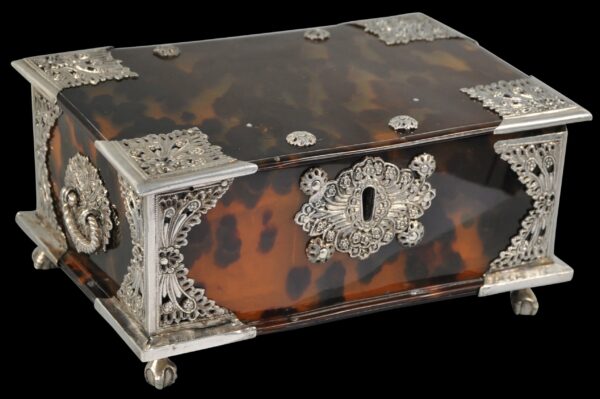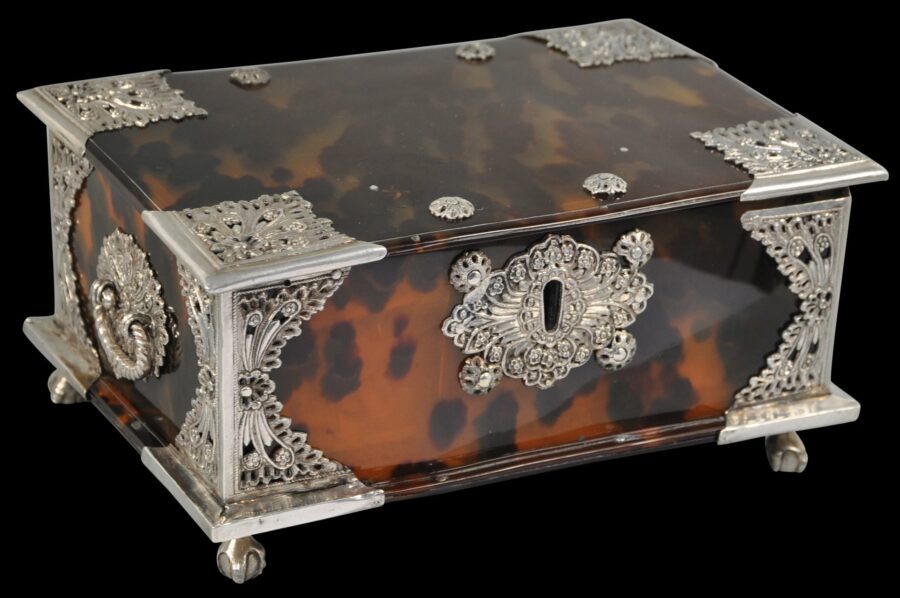This superb and elegant box is from the Malay people of the east coast of Sumatra. It is similar to boxes typically ascribed to Batavia and the Dutch East Indies. It is possible that it might also have come from the Malays of the Malay Peninsular (Malaysia).
It is made entirely of toffee-coloured tortoiseshell and pierced and chased, high-grade silver mounts. Typically such boxes were intended to hold betel or sirih, the mild social narcotic used by the Malays and which the colonial Dutch also took up as a habit. However, the interior of this example is lined with delicate Malay tekat couching and embroidery embellished with small metallic spangles, and very unusually, glass beadwork. Such an interior is not appropriate for a betel box. Nor would it have been practical if the box had been used to hold jewellery. The material onto which the tekat work has been done is yellow velvet. Yellow, among the Malays, was reserved for royalty, and so it seems likely that this box was made or repurposed to hold a Koran – but not a locally produced Koran, which usually are large, but more likely a smaller, foreign-produced Koran, perhaps one picked up on a Haj pilgrimage.
Such a use would have justified the extravagant silver mounts which are unusually complex. The corner mounts on the sides of the box are reminiscent of stylised butterflies with pierced wings.
The hinged cover and the keyplate are similarly elaborate and pierced, as are the lid supports inside the box which are especially elaborate.
The box stands on four delicate zoomorphic ball-and-claw feet. It has a ‘C’-form solid silver handle attached to each side. The lid is supported when open by the original silver chain inside.
The silver mounts have been carefully riveted using silver pins to the tortoiseshell and gently folded over the edges of the shell. The purity of the silver and consequent softness has allowed for such folding.
The box retains its original silver lock, though no longer is a key present.
When lit from behind or beneath the translucent quality and pleasing mottling of the tortoiseshell becomes very apparent.
Tekat is the Malay name given to the technique of decorating textile panels (usually velvet) with thickly applied gold thread decoration. When the thread is applied by couching, the technique is known as tekat timbul or tekat suji. Often the decoration is in the form of arabeques or flowers (bunga) as is the case here.
Sections of the decoration can be raised as well, and this was achieved by inserting small cut-out sections of cardboard (mempulur) and then covering them with the couching work. Additionally, small, metallic spangles often were sewn on. Again, this is seen here with this box.
The tekat used in this box is especially unusual because it is combined with the use of tiny red, orange, blue and pink glass trade beads, not only on the interior base but also the sides, including the side with the lock that is not readily visible to the user. This last example of attention to detail suggests the box was was indeed used for something especially precious such as a Koran.
The box is in excellent condition. There are no losses, chips or cracks to the tortoiseshell, and all the silver mounts are original and present. There is only some inevitable but very minor, age-related, warping of the tortoiseshell lid. Overall, this is a fine and rare item, made especially rare because of the tekat lining to the interior, which is in excellent condition, and which again suggests this box was used to hold a Koran rather than betel or jewellery.
References
Backman, M., Malay Silver and Gold: Courtly Splendour from Indonesia, Malaysia, Singapore, Brunei and Thailand, River Books, 2024.
Eliens, T.M., Silver from Batavia/Zilver uit Batavia, Gemeentemuseum Den Haag/W Books, 2012.
van de Geijn-Verhoeven, M., et al, Domestic Interiors at the Cape and in Batavia 1602-1795, Waanders Uitgevers, 2002.
Haags Gemeentemuseum, V.O.C. – Zilver: Zilver uit de periode van de Verenigde Oostinische Compagnie 17de en 18de eeuw, 1983.
Ismail, M.S.Z., et al., Muzium Tekstil Negara/National Textile Museum, Department of Museums Malaysia, 2012.
Tchakaloff, T.N. et al, La Route des Indes – Les Indes et L’Europe: Echanges Artistiques et Heritage Commun 1650-1850, Somagy Editions d’Art, 1998.
Krohn D.L. & P.N. Miller (eds.), Dutch New York Between East and West: The World of Margrieta van Varick, Bard Graduate Center/The New York Historical Society/Yale University Press, 2009.
Veenendaal, J., Furniture from Indonesia, Sri Lanka and India During the Dutch Period, Foundation Volkenkundig Museum Nusantara, 1985.
Veenendaal, J., Asian Art and the Dutch Taste, Waanders Uitgevers Zwolle, 2014.
















